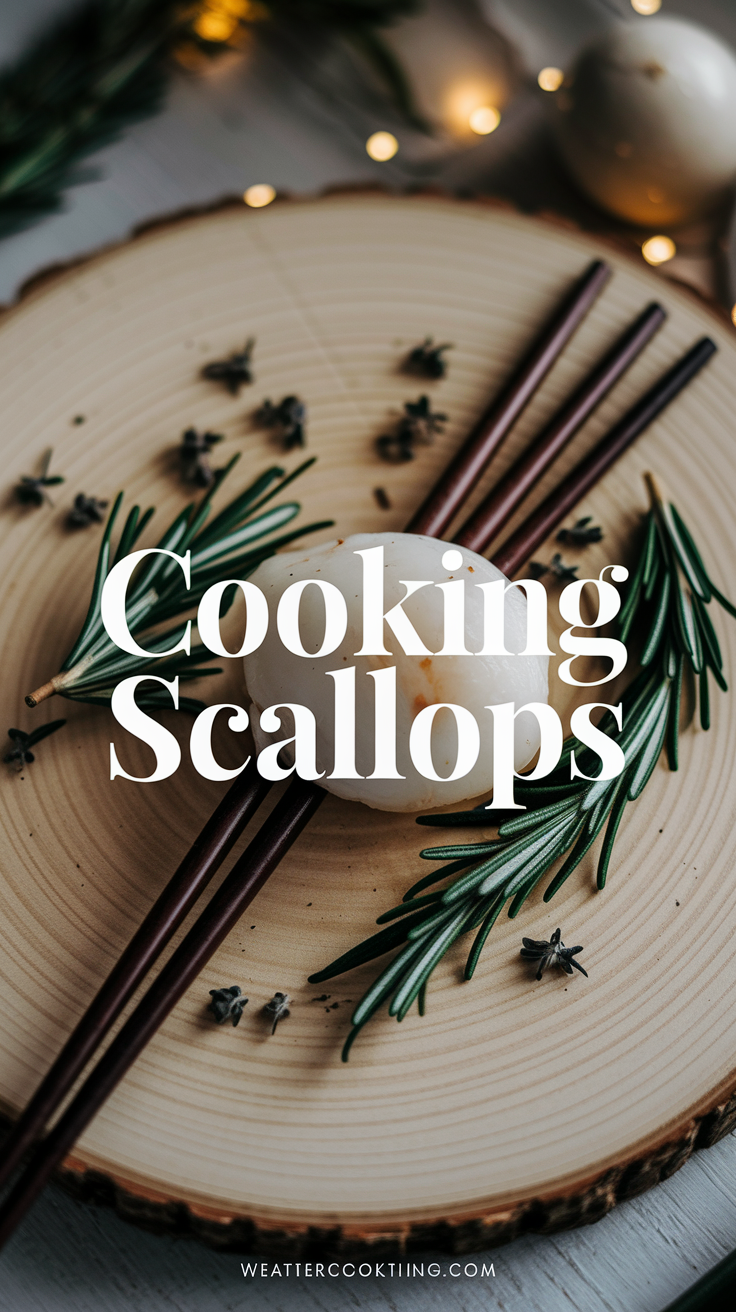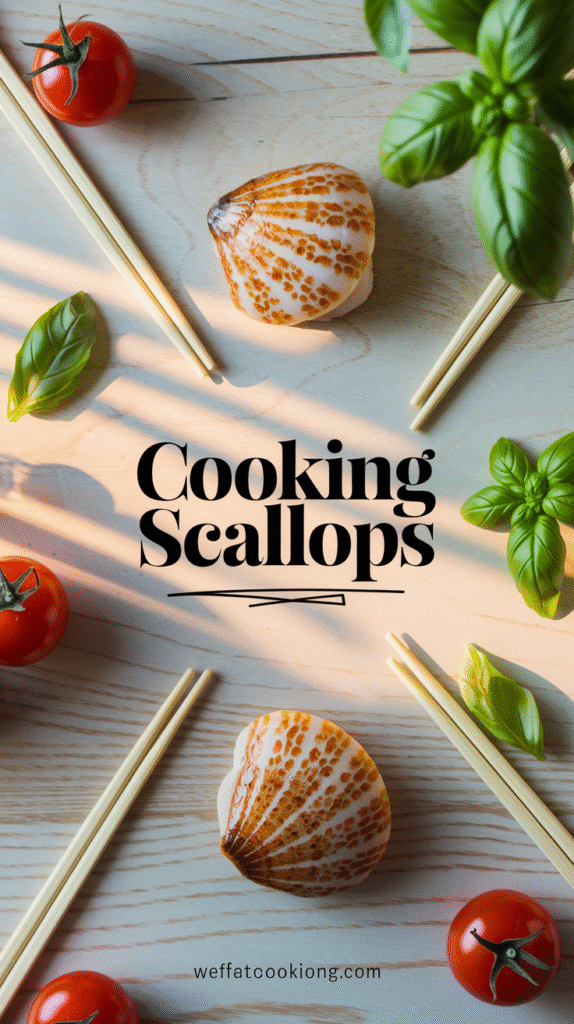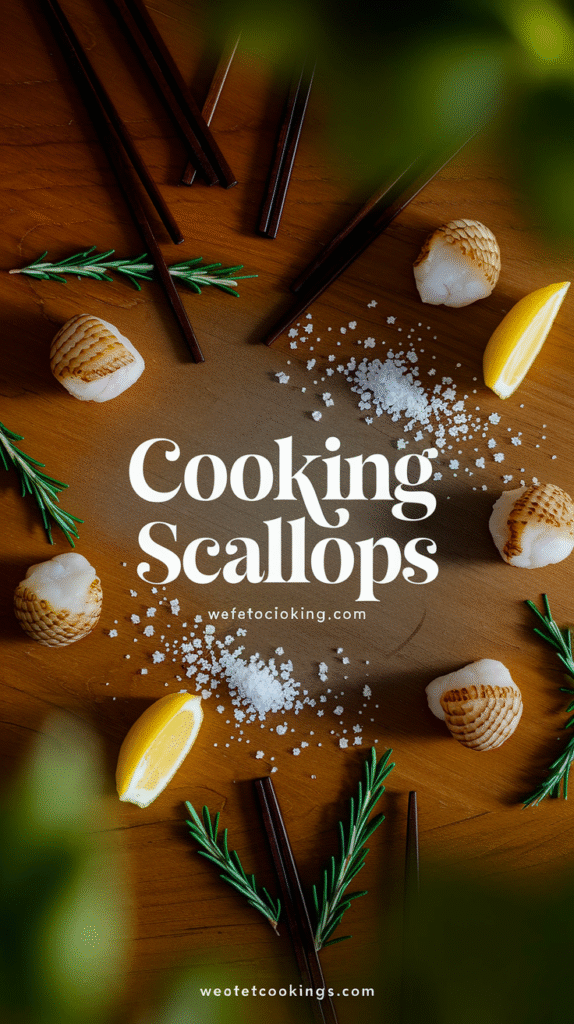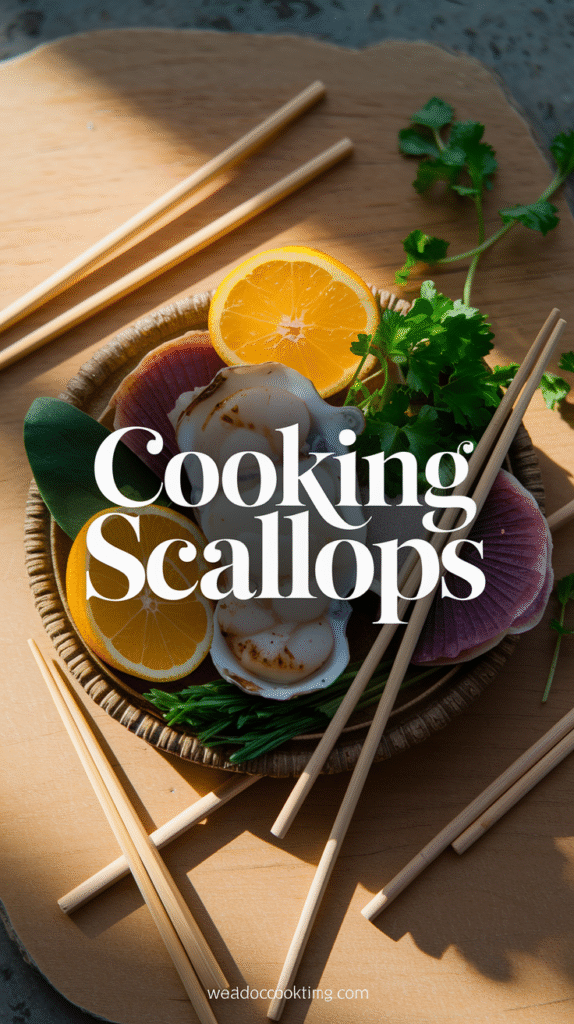Cooking scallops can feel intimidating, but with the right techniques, you can achieve perfectly seared shellfish in your own kitchen. These delicious mollusks are known for their sweet flavor and tender texture. To get started on your culinary journey, here are some essential tips to ensure your scallops shine on the plate.
Choosing the Right Scallops
The first step to cooking scallops is selecting the freshest, highest quality seafood. When buying scallops, keep these points in mind:
- Type: Look for dry scallops, which are not soaked in preservatives, offering a better texture and flavor.
- Appearance: Fresh scallops should be creamy white. Avoid any that appear overly wet or discolored.
- Smell: Fresh scallops should have a mild ocean scent, not an overpowering fishy odor.
Preparing Scallops for Cooking
Before cooking, ensure your scallops are properly prepped. This can greatly affect the outcome of your dish.
- Thawing: If you’re using frozen scallops, thaw them in the refrigerator overnight or under cold running water.
- Drying: Pat them dry with paper towels. Moisture is the enemy when searing, as it can create steam instead of a lovely golden crust.
- Seasoning: Keep it simple. A sprinkle of salt and pepper is often all you need to let their natural flavor shine.
Cooking Techniques for Perfect Scallops
Now that your scallops are prepped, it’s time to cook them! Here are some methods you can use:
| Cooking Method | Description | Notes |
|---|---|---|
| Searing | Cook in a hot skillet with oil for a crispy exterior. | Best for flavor and texture; use a cast-iron skillet for best results. |
| Baking | Place scallops in a baking dish with butter and broil or bake to cook through. | Great for larger batches; less attention required. |
| Grilling | Use skewers or a grill basket to prevent scallops from falling through the grates. | Add smokiness; be careful not to overcook. |
Searing Scallops to Perfection
If you choose to sear your scallops, follow these steps for optimal results:
- Heat your skillet on medium-high heat. You want it hot enough to create the sear but not so hot that it burns the scallops.
- Add a high-smoke-point oil, such as canola or grapeseed oil, followed by a pat of butter for flavor.
- Once the oil is shimmering, carefully place the scallops in the skillet, ensuring they are not touching each other.
- Cook undisturbed for 1.5 to 2 minutes until a golden crust forms. Flip and cook for an additional minute until just opaque.
Serving Scallops
Scallops are versatile and can be served in various ways:
- On a bed of creamy risotto.
- With a delicate lemon butter sauce.
- Alongside seasonal vegetables for a light meal.
Feel free to get creative! Pair them with herbs like parsley or chives for added freshness.
Storing Leftover Scallops
If you have any scallops left after your meal, it’s essential to store them properly. Place cooked scallops in an airtight container and refrigerate. They are best eaten within a day or two. For long-term storage, consider freezing them. Properly wrapped, they can last for up to three months. Just remember to thaw slowly before reheating.
Cooking scallops is not as difficult as it seems. With these tips in mind, you’re on your way to impressing family and friends. For further inspiration and recipes, check out New England’s Scallop Recipes and SeafoodSource’s Handling Guide for more information on this delectable shellfish.
Different Types of Scallops and Their Culinary Uses
Scallops are a much-loved seafood delicacy, and their delicate flavor and tender texture make them a popular choice in various dishes. There are multiple types of scallops, each offering unique properties that suit different culinary applications. Understanding the characteristics of these scallops can help you choose the best type for your next meal.
Primarily, there are two categories of scallops: bay scallops and sea scallops. Bay scallops are smaller, typically measuring around 1-2 inches in diameter, while sea scallops can grow to about 2-3 inches. Each of these varieties has specific uses in the kitchen.
Bay Scallops
Bay scallops are known for their sweet, mild flavor and tender texture. They are usually harvested from shallow coastal waters, making them easy to find in many regions. Here’s why bay scallops are a fantastic choice for your culinary creations:
- Perfect in salads: Their small size allows them to blend perfectly into fresh salads, adding a seafood twist.
- Great for stir-frying: Quick cooking methods work well with bay scallops, making them ideal for stir-fries.
- Wonderful in pasta dishes: Their sweet flavor pairs nicely with creamy or garlicky sauces, enhancing your favorite pasta meals.
Sea Scallops
In contrast, sea scallops are larger and have a more robust flavor, making them suitable for various preparations. Their meaty texture holds up well under a range of cooking techniques, allowing creativity in the kitchen. Here are some excellent uses for sea scallops:
- Seared to perfection: A popular method is to sear sea scallops. A quick browning creates a caramelized crust while keeping the inside tender.
- Grilled: The size and sturdiness of sea scallops make them perfect for grilling. Marinate them beforehand for added flavor.
- Baked: Pair them with breadcrumbs, herbs, and cheese and bake for a delicious entrée.
Other Varieties
There are some less common types of scallops impacting culinary landscapes. These include:
- Pink Scallops: Commonly found in warm waters, they have a mild taste and are often used in sushi.
- Pecten Scallops: Known for their large size and unique shell shape, they are favored in gourmet seafood dishes.
Additionally, scallops can be classified based on their harvest method. Wet and dry scallops are two examples. Dry scallops are preferred as they are minimally processed and generally considered fresher. Wet scallops are treated with a preservative solution that can affect their texture and flavor.
| Type of Scallop | Size | Flavor Profile | Culinary Uses |
|---|---|---|---|
| Bay Scallops | 1-2 inches | Sweet and mild | Salads, stir-fries, pasta dishes |
| Sea Scallops | 2-3 inches | Robust | Seared, grilled, baked dishes |
| Pink Scallops | 1-2 inches | Very mild | Sushi, light salads |
| Pecten Scallops | 2-4 inches | Rich | Gourmet seafood recipes |
When cooking scallops, keep in mind that they cook quickly. Overcooking can lead to a rubbery texture. Aim for a cooking time of only about 2-3 minutes per side, depending on size. This ensures that they retain their moisture and tenderness.
For those interested in deepening their knowledge of scallops, reputable resources like Science of Cooking and Seafood Watch provide valuable insights. They discuss different types of scallops, harvesting methods, and the importance of sustainability when enjoying these beauties of the sea.
Whether you are cooking bay scallops or sea scallops, each type offers unique flavors and textures that can elevate your dish. From searing to grilling and baking, the culinary possibilities are endless. So, the next time you’re in the market for seafood, consider trying out different types of scallops for a delectable dining experience!
Flavor Pairings That Enhance Scallop Dishes
Cooking scallops can be a delightful culinary adventure, particularly when you consider the various flavor pairings that can elevate their natural sweetness and delicate texture. Whether you are hosting a dinner party or cooking a simple weeknight meal, the right ingredients can truly enhance your scallop dishes.
Flavor Profiles That Compliment Scallops
When selecting flavors to pair with scallops, think about the balance between the natural sweetness of the scallops and other ingredients. Here are some essential pairings:
- Citrus: Lemon, lime, or orange add brightness and acidity that cut through the richness of scallops.
- Herbs: Fresh herbs like parsley, thyme, or dill provide freshness and aromatics that enhance the dish.
- Garlic: Adding minced garlic can bring depth and a savory punch to scallop preparations.
- Butter: A classic pairing, butter adds richness and a creamy texture that complements scallops beautifully.
- Chili Peppers: For those who enjoy a kick, green or red chili peppers can add heat and balance the sweetness.
Popular Sauces to Pair with Scallops
Sauces play a crucial role in enhancing scallop dishes. A well-crafted sauce can bring together various flavors to create a harmonious dish. Here are some popular sauces that work well:
- Beurre Blanc: This classic French butter sauce, made with white wine and shallots, enriches the dish and complements the scallops’ sweetness.
- Garlic Herb Sauce: Mixing garlic with fresh herbs and olive oil or butter can yield a fragrant sauce that elevates the entire dish.
- Chimichurri: This vibrant sauce made from parsley, garlic, vinegar, and olive oil introduces a zesty, fresh taste that matches well with scallops.
- Citrus Vinaigrette: A light vinaigrette made from citrus juice and olive oil can brighten up a scallop dish while keeping it healthy.
- Teriyaki Sauce: The sweet and savory notes of teriyaki sauce can add an Asian flair to grilled scallops.
Vegetable Pairings That Enhance the Dish
Vegetables not only adds color and texture but also layers of flavor. Here are some great vegetable pairings:
| Vegetable | Flavor Profile |
|---|---|
| Asparagus | Earthy, fresh |
| Peas | Sweet, crisp |
| Carrots | Sweet, slightly tangy |
| Spinach | Earthy, tender |
| Fennel | Anise-like, fresh |
These vegetables can be sautéed, roasted, or served fresh alongside scallops for a complete meal.
Choosing the Right Wine
Pairing wine with scallops is all about enhancing the flavors while respecting the dish. A few excellent wine options include:
- Sauvignon Blanc: Its refreshing acidity pairs well with the sweetness of scallops.
- Chardonnay: A lightly oaked Chardonnay complements the buttery flavors of scallops.
- Pinot Grigio: Known for its crispness, this wine works well with various scallop preparations.
- Bubbles: Sparkling wine or Champagne can add a celebratory touch, particularly with fried scallops.
Exploring flavor pairings that enhance scallop dishes opens a world of culinary possibilities. With the right ingredients and techniques, you can create a restaurant-quality meal at home. For more inspiration and rich recipes, visit Food Network or check out the extensive guide on scallops available at Serious Eats.
Common Mistakes to Avoid When Cooking Scallops
Cooking scallops can be an exquisite experience, but several common mistakes can turn your culinary delight into a frustrating endeavor. Avoiding these pitfalls will ensure that your scallops are perfectly cooked, flavorful, and appealing. Here are key mistakes to be aware of when preparing this delicious seafood.
Choosing the Wrong Scallops
When selecting scallops, fresh quality is crucial. Look for wet scallops, which are often soaked in a solution to increase weight and shelf life. Although they may look appealing, they can have a less desirable texture once cooked. Always opt for “dry” scallops, which are not treated with preservatives and have a more concentrated flavor.
Skipping the Proper Thawing Process
If you’re using frozen scallops, don’t rush the thawing process. Thaw them slowly in the refrigerator for several hours or overnight. If you need to speed it up, place them in a sealed bag and submerge them in cool water for about 30 minutes. Avoid microwaving them, as this can cook parts of the scallops unevenly.
Neglecting to Pat Them Dry
Moisture is a scallop’s enemy when it comes to achieving the desired caramelization. Always pat the scallops dry with paper towels before cooking. This step ensures a nice sear, bringing out the natural sweetness of the scallops and providing a delightful texture.
Cooking on Too Low Heat
One significant error is cooking scallops at a low temperature. High heat is essential for proper caramelization. Preheat your pan until it’s hot before adding oil. The goal is to create a golden-brown crust. A medium-high heat setting is optimal, ensuring you get that delicious sear while cooking the interior to perfection.
Overcrowding the Pan
When cooking scallops, give them space. Crowding the pan causes steam instead of searing, resulting in rubbery scallops. Cook them in batches if necessary, ensuring there is enough space for each scallop to sear properly. Two to three scallops should fit comfortably in a standard skillet.
Timing is Everything
It’s easy to overcook scallops, turning them from tender and juicy to tough and chewy. Depending on the size, scallops typically require 2-3 minutes on each side for proper cooking. Watch for that golden-brown color and a slightly opaque center; that’s your signal that they’re done! Use a timer or intuitive cooking if you need to increase your confidence.
Using Too Much Oil or Butter
While a little fat is essential for cooking scallops, using too much can mask their natural flavor. A tablespoon of high-smoke point oil, like grapeseed or avocado oil, is sufficient. You can finish with a small amount of butter for flavor, but be cautious not to overpower the scallops.
Ignoring Flavor Enhancements
Salt and pepper are your friends when cooking scallops, but don’t stop there. Enhance the natural flavors with lemon juice, garlic, or fresh herbs. A sprinkle of fresh parsley or chives post-cooking will elevate your dish. A simple herb butter or citrus sauce can also complement scallops beautifully.
Not Resting After Cooking
After cooking, let the scallops rest for a minute before serving. This allows the juices to redistribute, enhancing the overall flavor and texture. This short resting period is essential in retaining moisture, ensuring you enjoy succulent scallops.
By avoiding these common mistakes, you’ll be well on your way to mastering the art of cooking scallops. Whether you’re preparing them as a light appetizer or the star of your main course, a little attention to detail will make a huge difference. For tips, recipes, and more seafood-related information, consider visiting Food Network or Scallops Recipes.
Happy cooking and enjoy those perfectly cooked scallops!
Quick and Easy Scallop Recipes for Weeknight Dinners
Cooking scallops is a fantastic way to whip up a meal that’s both delicious and quick. These tender, sweet morsels can elevate any weeknight dinner without requiring hours in the kitchen. Whether you prefer to sauté, grill, or bake them, there are plenty of easy scallop recipes that will impress your family and friends.
When cooking scallops, you’ll discover that they cook very quickly. This makes them an excellent choice for weeknight dinners when time is at a premium. Here are three quick and easy scallop recipes that you can prepare in under 30 minutes:
Pan-Seared Scallops
Pan-searing is perhaps the most popular method for cooking scallops. Here’s how to do it:
- Ingredients:
- 1 pound of sea scallops
- 2 tablespoons of olive oil
- Salt and pepper to taste
- 1 tablespoon of lemon juice
- Fresh parsley for garnish
- Heat the olive oil in a skillet over medium-high heat.
- Pat the scallops dry and season with salt and pepper.
- Once the oil is hot, add the scallops to the pan in a single layer.
- Cook for about 2-3 minutes per side until they are golden brown.
- Drizzle with lemon juice and garnish with chopped parsley before serving.
These pan-seared scallops can be served over a bed of risotto or alongside steamed vegetables for a well-rounded meal.
Garlic Butter Scallops
For a rich and flavorful option, garlic butter scallops are a perfect choice. This recipe enhances the natural sweetness of the scallops with the savory taste of garlic.
- Ingredients:
- 1 pound of scallops
- 4 tablespoons of butter
- 3 cloves of garlic, minced
- Salt and pepper to taste
- Chopped parsley for garnish
- In a skillet, melt the butter over medium heat.
- Add minced garlic and sauté for about 30 seconds until fragrant.
- Increase the heat and add the scallops to the skillet.
- Cook for approximately 2-3 minutes on each side until golden.
- Season with salt and pepper, then sprinkle with parsley before serving.
This dish pairs nicely with a simple salad or crusty bread to soak up the delicious garlic butter sauce.
Baked Scallops with Parmesan
If you prefer a baking method, baked scallops are a fantastic way to make a hassle-free dinner. This recipe uses minimal ingredients and yields maximum flavor.
- Ingredients:
- 1 pound of scallops
- 1/2 cup of breadcrumbs
- 1/2 cup of grated Parmesan cheese
- 2 tablespoons of melted butter
- 1 teaspoon of garlic powder
- Salt and pepper to taste
- Preheat your oven to 375°F (190°C).
- In a bowl, combine breadcrumbs, Parmesan cheese, melted butter, garlic powder, and season with salt and pepper.
- Place scallops in a single layer in a baking dish.
- Spoon the breadcrumb mixture over each scallop.
- Bake for 15-20 minutes or until the tops are golden brown and the scallops are cooked through.
Serve with a side of a fresh green salad or roasted asparagus for a complete meal.
Cooking scallops does not have to be complicated or time-consuming. With these quick recipes, you can serve a gourmet meal any night of the week. They are perfect for those who crave seafood but want to keep it simple and satisfying.
For additional tips on cooking scallops or discovering new recipes, visit Food Network or get inspired by Serious Eats. Happy cooking!
Conclusion
Cooking scallops can be a delightful adventure in your culinary journey. With the right tips for perfectly searing these shellfish, you can achieve that coveted golden-brown crust while keeping the inside tender and flavorful. Understanding the different types of scallops—such as sea and bay scallops—can open up a world of possibilities for your recipes, as each type has its own unique texture and taste profile.
Pairing flavors is key when creating delightful scallop dishes. Ingredients like citrus, garlic, and fresh herbs can beautifully enhance the natural sweetness of scallops, making your meal memorable. However, it’s just as important to be aware of common mistakes, like overcooking or using the wrong pan, to ensure your scallops shine on the plate.
For those busy weeknights, quick and easy scallop recipes allow you to whip up delicious meals without spending hours in the kitchen. Whether you choose to sauté them with some veggies, toss them in pasta, or serve them over risotto, scallops can bring a touch of elegance to any dinner.
By staying mindful of these essential tips and strategies, you can elevate your scallop cooking game and impress family and friends alike. So next time you’re in the kitchen, don’t hesitate to experiment with scallops—they’re versatile, delicious, and sure to become a favorite in your household. Happy cooking!







Leave a Reply